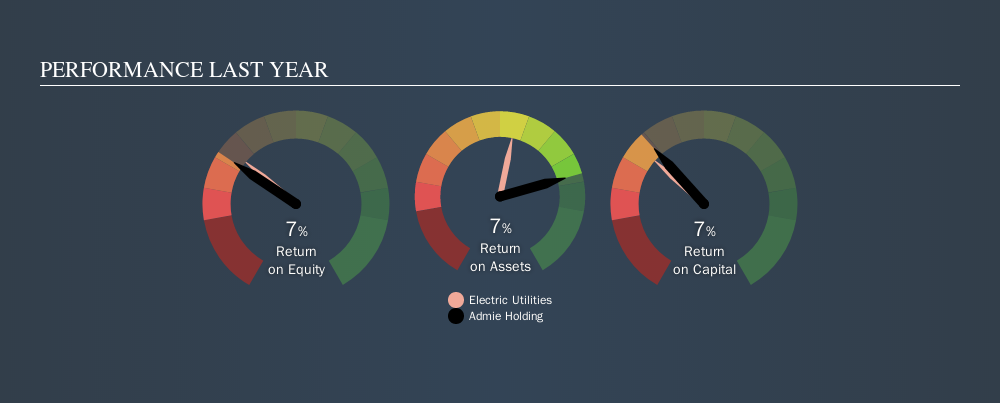- Greece
- /
- Electric Utilities
- /
- ATSE:ADMIE
Does Admie Holding S.A.’s (ATH:ADMIE) ROCE Reflect Well On The Business?

Today we are going to look at Admie Holding S.A. (ATH:ADMIE) to see whether it might be an attractive investment prospect. In particular, we'll consider its Return On Capital Employed (ROCE), as that can give us insight into how profitably the company is able to employ capital in its business.
Firstly, we'll go over how we calculate ROCE. Next, we'll compare it to others in its industry. Then we'll determine how its current liabilities are affecting its ROCE.
Understanding Return On Capital Employed (ROCE)
ROCE measures the amount of pre-tax profits a company can generate from the capital employed in its business. In general, businesses with a higher ROCE are usually better quality. Overall, it is a valuable metric that has its flaws. Author Edwin Whiting says to be careful when comparing the ROCE of different businesses, since 'No two businesses are exactly alike.
So, How Do We Calculate ROCE?
Analysts use this formula to calculate return on capital employed:
Return on Capital Employed = Earnings Before Interest and Tax (EBIT) ÷ (Total Assets - Current Liabilities)
Or for Admie Holding:
0.07 = €41m ÷ (€585m - €14k) (Based on the trailing twelve months to June 2019.)
So, Admie Holding has an ROCE of 7.0%.
Check out our latest analysis for Admie Holding
Is Admie Holding's ROCE Good?
When making comparisons between similar businesses, investors may find ROCE useful. Using our data, Admie Holding's ROCE appears to be around the 7.4% average of the Electric Utilities industry. Independently of how Admie Holding compares to its industry, its ROCE in absolute terms is low; especially compared to the ~4.9% available in government bonds. There are potentially more appealing investments elsewhere.
You can see in the image below how Admie Holding's ROCE compares to its industry.

When considering ROCE, bear in mind that it reflects the past and does not necessarily predict the future. ROCE can be deceptive for cyclical businesses, as returns can look incredible in boom times, and terribly low in downturns. This is because ROCE only looks at one year, instead of considering returns across a whole cycle. Since the future is so important for investors, you should check out our free report on analyst forecasts for Admie Holding.
Admie Holding's Current Liabilities And Their Impact On Its ROCE
Short term (or current) liabilities, are things like supplier invoices, overdrafts, or tax bills that need to be paid within 12 months. Due to the way the ROCE equation works, having large bills due in the near term can make it look as though a company has less capital employed, and thus a higher ROCE than usual. To counteract this, we check if a company has high current liabilities, relative to its total assets.
Admie Holding has total liabilities of €14k and total assets of €585m. As a result, its current liabilities are equal to approximately 0.002% of its total assets. Admie Holding has very few current liabilities, which have a minimal effect on its already low ROCE.
What We Can Learn From Admie Holding's ROCE
Still, investors could probably find more attractive prospects with better performance out there. You might be able to find a better investment than Admie Holding. If you want a selection of possible winners, check out this free list of interesting companies that trade on a P/E below 20 (but have proven they can grow earnings).
If you like to buy stocks alongside management, then you might just love this free list of companies. (Hint: insiders have been buying them).
We aim to bring you long-term focused research analysis driven by fundamental data. Note that our analysis may not factor in the latest price-sensitive company announcements or qualitative material.
If you spot an error that warrants correction, please contact the editor at editorial-team@simplywallst.com. This article by Simply Wall St is general in nature. It does not constitute a recommendation to buy or sell any stock, and does not take account of your objectives, or your financial situation. Simply Wall St has no position in the stocks mentioned. Thank you for reading.
About ATSE:ADMIE
Admie Holding
Operates, controls, maintains, and develops an electricity transmission system for the supply of electricity in Greece.
Very undervalued with flawless balance sheet.
Market Insights
Community Narratives


